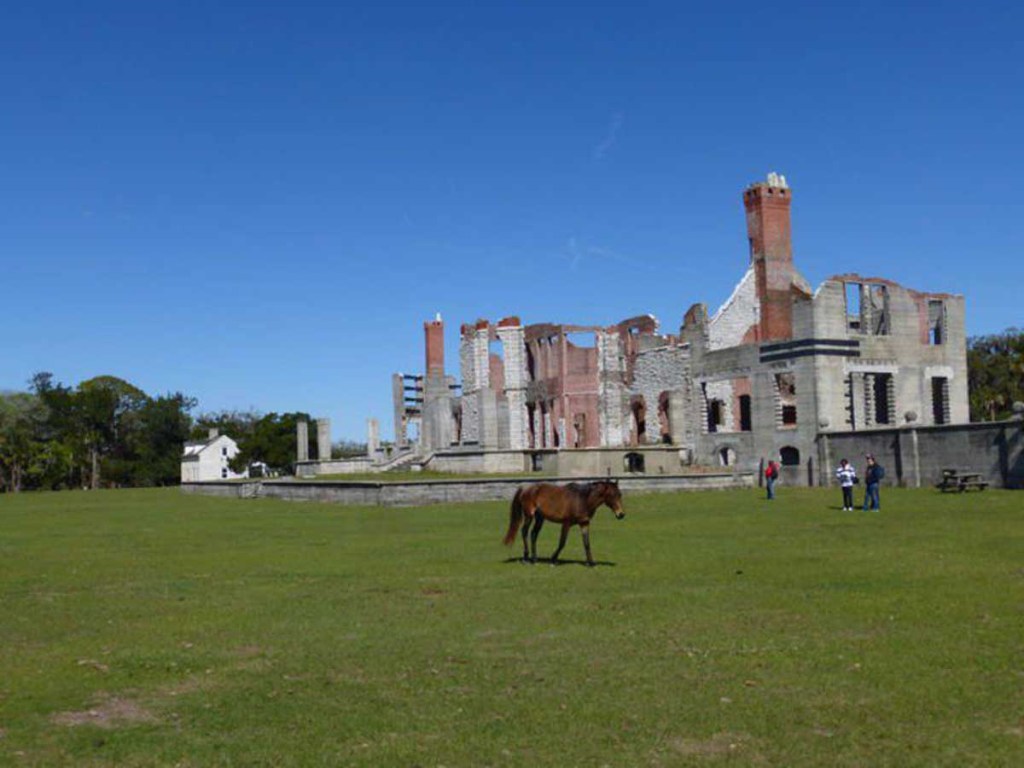Horses roam free on Georgia island where the Carnegies lived
Published 12:00 am Sunday, March 26, 2017

- The Carnegie’s Dungeness mansion that burned down in 1959 after being unoccupied for many years
Telling others during our travels that we are from Georgia often results in someone mentioning they experienced an enjoyable visit to Savannah, Jekyll Island or St. Simons Island. These are trendy Georgia tourist destinations and all three could easily be visited during a single trip along Georgia’s 100-mile Atlantic coastline.
When we mention our own favorite Georgia destination of Cumberland Island National Seashore, even experienced travelers generally offer a blank stare. Not only have they not visited the island, most have never heard of it. The unfamiliarity is their loss because the island is one of America’s true jewels.
At over 36,000 acres, Cumberland Island is Georgia’s largest and southernmost barrier island. Unlike the state’s heavily-developed barrier islands, Cumberland Island remains primarily in a natural state. Most of the land and surrounding marsh have been acquired by the U.S. Government for the establishment of Cumberland Island National Seashore, a unit of the National Park Service. Several private parcels of land remain, some of which will revert to the National Park Service at the deaths of the owners.
Cumberland Island has served as home to Native Americans, Spanish priests, British soldiers, and plantation owners. It is perhaps best known as a family estate of Thomas and Lucy Carnegie. Thomas was the younger sibling of the more famous Andrew Carnegie, steel magnate and philanthropist. In more recent years the island gained recognition as the location of John F. Kennedy, Jr.’s marriage to Carolyn Bessette.
The Carnegies acquired property on the island in the early 1880s and in 1884 began construction of their mansion, Dungeness, on the site of an earlier structure of the same name built by the widow of Revolutionary War hero Nathanael Greene. Greene had obtained a land grant from the U.S. Government.
Thomas Carnegie passed away in 1886, a year after completion of Dungeness, but his widow continued to live in the mansion and raise her nine children on the island. She built several additional homes for her married children whom she wished to remain on Cumberland Island.
Intertwining the island’s human history with its natural beauty – the peaceful marsh areas, beautiful live oak trees, and miles of stunning ocean beach – make Cumberland Island a special place visitors long remember.
We recently returned from our fourth visit to Cumberland Island and it was everything we remembered and more. The two of us split up, with one taking the day-long narrated van tour to the north end of the island, while the other spent the day on the island’s south end walking the trails, strolling the beach, and exploring the remains of Thomas and Lucy Carnegie’s Dungeness mansion.
Cumberland Island is accessible only via private boat or a National Park Service passenger ferry. The concessionaire-operated ferry offers service twice a day between the small village of St. Marys, Georgia, and the island. Tickets are sold at the nearby National Park Service visitor center. Reservations are recommended.
St. Marys is home to motels, several bed-and-breakfasts and an historic downtown hotel that remains in operation across from the boat dock. The hotel bar is worth a look. The town has an impressive waterfront park and several nearby restaurants.
The island has one historic bed-and-breakfast – the Greyfield Inn – but it is expensive, with rooms running up to $600 a night. Camping facilities are available for those who wish to tent. However, most visitors are day-trippers who depart on the early boat and return in the late afternoon. No food service is available on the island so visitors are advised to pack a lunch that includes a water bottle. Jill Hamilton-Anderson, National Park Service chief of interpretation, told us the park service tries to convey to visitors that they should arrive on the island self-sufficient for however long they plan to stay.
The majority of Cumberland Island’s 60,000 annual visitors, other than campers and guests of the B & B, spend about seven hours on the island. Our next column will explain why the national seashore deserves two full days, as we describe some of the island’s interesting experiences and sights.
• David and Kay Scott are authors of “Complete Guide to the National Park Lodges” (Globe Pequot). Visit them at www.valdosta.edu/~dlscott/Scott





